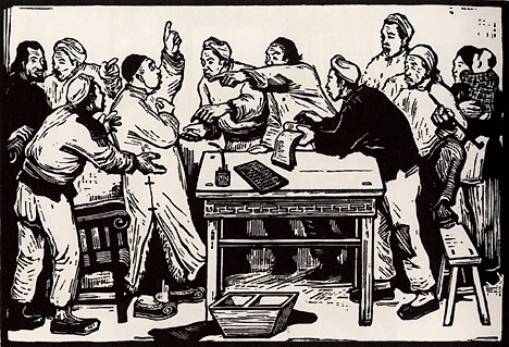
| The New Woodcut Movement of the 1930s and 40s was begun by the writer and scholar Lu Xun. | |||||
What is the weapon of protest associated with Lu Xun in the woodcut portrait on the right? |
|||||
|
|
||||

| The New Woodcut Movement of the 1930s and 40s was begun by the writer and scholar Lu Xun. | |||||
What is the weapon of protest associated with Lu Xun in the woodcut portrait on the right? |
|||||
|
|
||||
|
|
From the time of the May Fourth protests in 1919, Japan was seen as the greatest threat to China's sovereignty. By the 1930s Japan had taken over most of Manchuria and set up a puppet state there. In 1932 the Japanese attacked Shanghai directly to retaliate against anti-Japanese protests. Anger at Japanese aggression heightened Chinese nationalism. In the woodcuts of this period patriotic young artists called for resistance to the invaders and criticized the Nationalist government for not taking decisive action. Does the woodcut medium enhance the emotional impact of the image to the left? Is so, how? |
||||
|
“Roar, China!”
|
|||||
|
In the early twentieth century, assumptions about women's place in society that had gone unquestioned for centuries came under attack. What do you think are some of the practices being criticized in this woodcut print? Do
you see similarities to the print above?
|
|
||||
|
“Women of China”
|
|||||
|
Although Lu Xun was never an official member of the Communist Party, his emphasis on the exploitation of peasants and the working class fit well with the revolutionary message of the CCP. In 1937, after Lu Xun's death, the Lu Xun Academy of Arts was established at the Communist base of Yan’an to instruct artists in the art of propaganda. Woodblock prints were particularly suited for this purpose because they were relatively cheap and easy to copy. By the 1940s there were artists traveling through the countryside distributing prints with ideological messages. In the 1943 woodcut below, what do you think is happening? What role do you think the man in the long robe is playing? |
|||||
|
|||||

|
|||||
|
|||||
|
Move on to PRC under Mao |
|||||